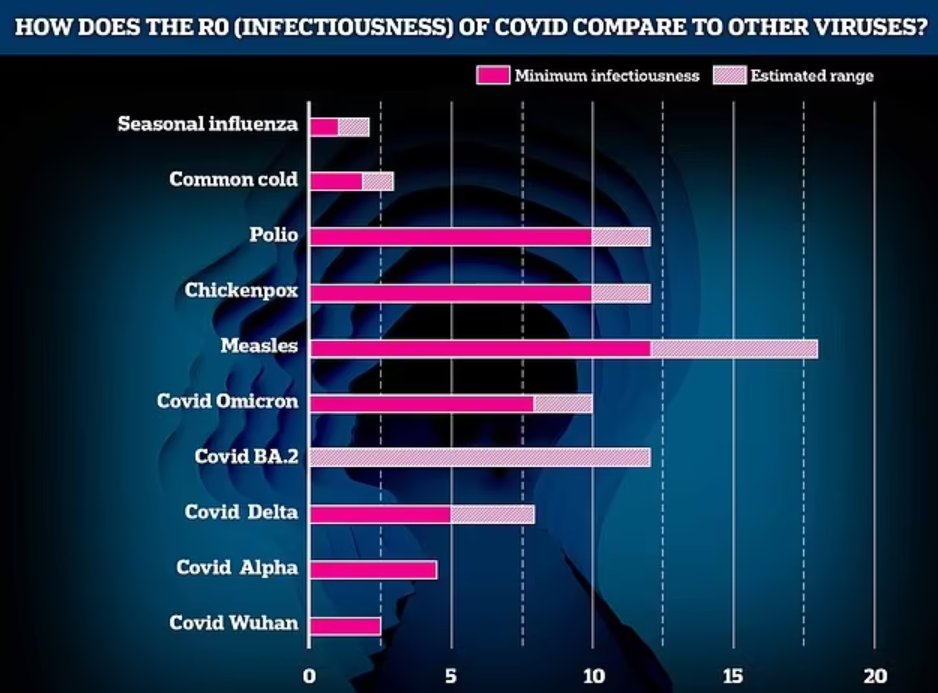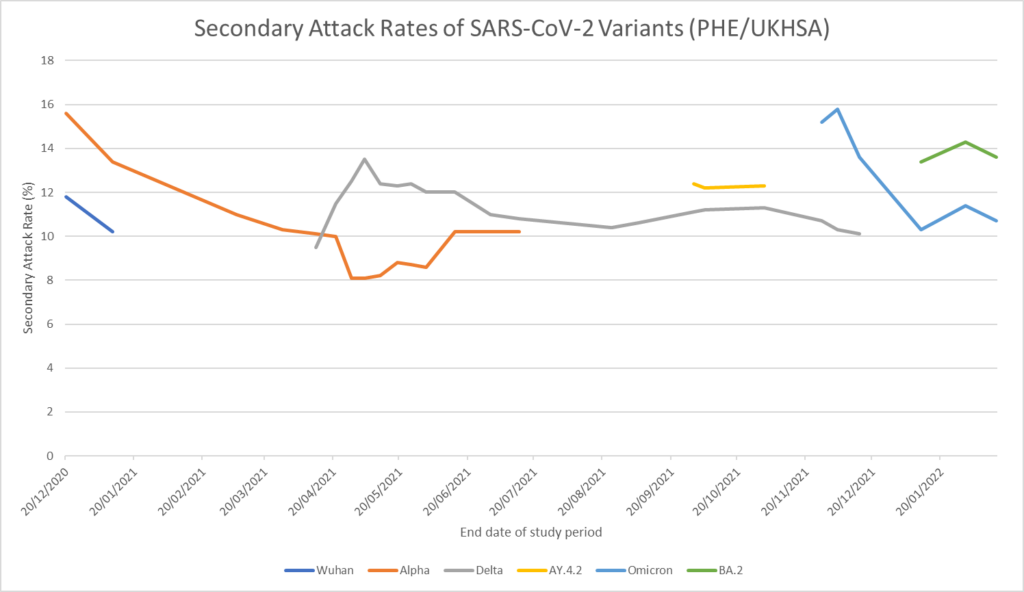A former World Health Organisation (WHO) official has claimed that the BA.2 subvariant of Omicron has a basic reproduction number (R0) of around 12 (each infected person passes it on to 12 others), making it as infectious as measles, the most contagious disease known, and nearly six times as infectious than the original Wuhan strain (with an R0 of 2.5). Here’s the report in MailOnline.
Professor Adrian Esterman, a leading epidemiologist in Australia, said BA.2 is 40% more transmissible than the original variant.
He claimed it would have a basic reproduction number (R0) of around 12, meaning if left to spread unchecked every infected person would pass it to a dozen others.
It would make the sub-strain five times more infectious than the original Wuhan virus and one of the most contagious diseases known to science.
The claim would explain why the mutant virus was able to outstrip its parent strain in the U.K. in about a month and undermine China’s Zero Covid policy, which has until now managed to suppress every version of the virus.
Explaining his methodology, Professor Esterman said: “The basic reproduction number (R0) for BA.1 is about 8.2, making R0 for BA.2 about 12. This makes it pretty close to measles, the most contagious disease we know about.”
The R0 number is the average number of people each BA.2 patient would infect, if there was no immunity in a population or behavioural changes.
But most scientists say there is no reason to be concerned over the variant because it is just as mild as the original Omicron.
The BA.2 subvariant is now behind almost every case in England, or 83% of infections last week, according to official estimates.
It became dominant three weeks beforehand, accounting for 52% of all infections in the week to February 20th.
The Office for National Statistics (ONS) estimates cases have been rising since mid-February, with one in 25 people in England estimated to have been infected last week.
Hospitalisations are also creeping up, but the majority appear to be incidental – when someone tests positive after admission for another illness.

But how accurate are these estimates of infectiousness? The UKHSA (and previously PHE) publishes estimates of the secondary attack rates (SARs; the proportion of contacts an infected person infects) of the coronavirus variants in its Technical Briefings. I have plotted some of them in the chart below.

While each data point comes from a PHE or UKHSA Technical Briefing, I should emphasise that these data are not entirely ‘clean’. In particular, the start dates for the studies vary. Also, the first two data points are “direct” SAR, then the next seven are overall SAR, and the rest are “household” SAR – ‘direct’ appears to be broadly comparable to ‘household’, while overall is similar to ‘household’ because the large majority of contacts are household contacts. Thus the anomalous dip in the Alpha SAR results in part from the start date switching to March for six data points. However, despite these limitations, the values are instructive as they give an indication of how the secondary attack rates of different variants change over time and compare with one another.
They show, for example, that the household or direct SAR of any coronavirus variant, as recorded by the U.K. Government, has not exceeded 16%. Alpha when it first appeared had a direct SAR of 15.6%, and Omicron had a household SAR of 15.8%. This means no variant has infected more than 16% of household/direct contacts, and equivalently 84% of household/direct contacts have remained uninfected. We also see that this SAR for each variant declines rapidly to around 10-11%, where it remains. The Delta variant shows that the decline doesn’t necessarily continue, and its SAR actually rose slightly as we went into autumn – a seasonal effect perhaps – sustaining its wave at a relatively low level throughout the second half of 2021. We also see subvariants AY.4.2 (Delta) and BA.2 (Omicron) emerge with higher SARs, which help to sustain their respective waves. BA.2 in particular had an SAR of around 14% when it first appeared, giving the Omicron wave its recent boost. Note, however, that BA.2’s SAR is still under the original Omicron’s initial SAR, and indeed that of Alpha in December 2020. It’s hard to reconcile this with the claim that BA.2 is several times more infectious than the Wuhan strain or Alpha variant, or as infectious as measles. UKHSA data suggest rather it is less infectious than Omicron was in December.
It might be argued that there is more population immunity for later variants, so that the SARs are not directly comparable. However, Omicron has shown significant immune evasion when causing infection, plus it’s hard to see increased population immunity making a huge difference for BA.2 compared to Omicron within a few weeks. Also, it could be argued that households are typically exposed all at once due to difficulties in avoiding exposure when living under the same roof, limiting the impact of population immunity on household transmission rates.
On the other hand, it may be true that population immunity is stunting the spread of new variants within households. It would be worth quantifying the size of this effect. But either way, the SARs as measured by UKHSA and PHE are significant indicators of the actual level of infectiousness of each variant in the current population. And, importantly, they show a disease that has not yet managed to infect more than 16% of household contacts.












To join in with the discussion please make a donation to The Daily Sceptic.
Profanity and abuse will be removed and may lead to a permanent ban.